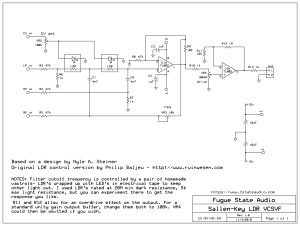This is a 12dB/oct Sallen-Key state-variable filter (SVF), a circuit I tweaked and built for my DIY modular. There are several variations on this basic design (including the filter of the Korg MS-20 and others), the one I built is based on a design by Nyle A. Steiner (original schematic at Experimentalists Anonymous, Philip Baljeu’s mod/redraw with LDR’s in this electro-music.com thread). I made a few changes, including changing the gain on the output buffer (it’s now set at 100x gain, well into overdrive territory- but the volume pot allows you to attenuate the signal), and changing the res pot’s value. I think it sounds pretty good.
It’s a quick & dirty build, but it works if you just want a controllable filter and aren’t worried about 1V/oct compatibility or anything like that. Should work at other voltages like +/-15 too, this was built for the power supply I had. The op amps are just there as amplifiers, so I don’t think much would change other than headroom.
You may notice a lack of current-limiting resistors on the “Vactrol” LED’s, that’s because they were not needed in my use case. Ymmv.
What’s basically going on:
The LDRs (light-dependent resistors), along with capacitors C1 and C2, set up a cascaded RC network (resistor/capacitor), creating a 2-pole lowpass filter. The highpass and bandpass filters are derived by feeding signals into different parts of the circuit, such that the resistors and capacitors create those responses from the perspective of those signals, so to speak. Note that the feedback which creates the filter resonance is also fed into the bandpass part of the filter. Moritz Klein has a good explanation of how the resonance/feedback part of this circuit works in this video— the circuit in the video is a different implementation of the overall filter, but is using similar concepts.
The first opamp is essentially creating a buffer so that the filter circuit isn’t affected by whatever the output is plugged into, and also makes resonance (feedback) possible. The second opamp isn’t strictly necessary, but allows us to boost the signal level, and in this case, also provides some nice overdrive.
This is actually a fairly simple build, the main reason for the 3-star complexity rating is because of the homemade Vactrols, which can be a bit fiddly.
